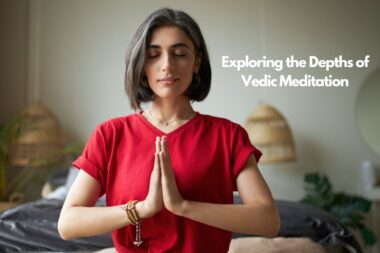Vedic meditation, an ancient technique rooted in the spiritual traditions of India, has emerged as a cornerstone in the modern pursuit of wellness and inner peace. This practice, steeped in the wisdom of the Vedas, offers a simple yet profound path to transcendence, self-discovery, and mental clarity.
As individuals around the world seek ways to cope with the stresses of modern life, Vedic meditation provides a timeless solution, offering a retreat into the tranquillity of one’s inner world.
Origins and Philosophy of Vedic Meditation
Vedic meditation originates from the Vedic tradition of India, a culture rich in spiritual and philosophical exploration. The Vedas, ancient texts considered to be among the oldest scriptures in human history, lay the foundation for this meditative practice.
This form of meditation is not just a practice but a philosophy that encompasses a holistic view of life and consciousness. It’s based on the principle that an underlying field of pure consciousness, or ‘Atman’, exists within everyone, and accessing this field is the key to achieving deep inner peace and enlightenment.
The Practice of Vedic Meditation
At its core, Vedic meditation involves the use of a personalized mantra. A mantra in this context is a sound or vibration, often derived from Sanskrit, that is repeated silently to facilitate a deep state of relaxation and to help the practitioner transcend thought.
Unlike other forms of meditation that focus on concentration or mindfulness, Vedic meditation uses the effortless repetition of the mantra to settle the mind into a state of profound stillness and rest. Typically, this practice is done twice a day, each session lasting about 20 minutes.
Benefits of Vedic Meditation
Practitioners of Vedic meditation often report a wide range of benefits. These include reduced stress and anxiety, improved mental clarity and focus, increased creativity, and a greater sense of well-being.
Physiologically, the practice has been linked to lower blood pressure, improved sleep patterns, and a stronger immune system. Perhaps the most significant benefit, however, is the experience of deep inner peace and connection to a greater sense of purpose and self.
Learning Vedic Meditation
For those interested in beginning their journey with Vedic meditation, it is often recommended to learn from a qualified teacher. These instructors offer guidance on the selection of a suitable mantra and provide instructions on the technique’s nuances.
As the interest in Vedic meditation grows, finding meditation courses near me has become easier. Many meditation centers and wellness groups now offer classes in Vedic meditation, making it accessible to a wide audience. These courses provide an invaluable opportunity to learn the practice in an environment that fosters growth and community.
Vedic Meditation in Daily Life
Integrating Vedic meditation into daily life can be a seamless process. The practice itself requires no special equipment or location – just a comfortable place to sit and a few minutes of your time.
Many practitioners find that their meditation sessions become an essential part of their day, akin to eating or sleeping. Over time, as the practice deepens, the sense of calm and clarity experienced during meditation begins to permeate all aspects of life.
The Mantra in Vedic Meditation

The selection of the mantra in Vedic meditation is a unique aspect of this practice. Mantras are typically given by a teacher and are chosen based on a variety of factors including the individual’s needs and life circumstances.
The mantra acts as a vehicle to transport the mind from the surface levels of thought to the deeper realms of consciousness. It is neither worshipped nor contemplated upon; instead, it serves as a subtle and effortless point of focus.
Advanced Techniques and Retreats
For those who wish to deepen their practice, advanced techniques and retreats are available. These advanced practices are designed to enhance the benefits of meditation and provide deeper insight into Vedic philosophy.
Retreats offer a conducive environment for extended practice and often include additional teachings on Vedic wisdom and lifestyle.
Vedic Meditation and Modern Science
The growing interest in Vedic meditation has sparked scientific studies into its effects. Research has shown that the practice can lead to significant reductions in stress, anxiety, and depression.
Studies have also indicated improvements in brain function, including increased creativity and problem-solving skills. These findings have contributed to a greater understanding and acceptance of Vedic meditation in the West.
Vedic Meditation and Other Traditions
Vedic meditation, while unique in its approach, shares commonalities with various other spiritual and meditative traditions. Its emphasis on transcending thought and accessing a deeper level of consciousness is a theme echoed in many paths of spiritual practice.
This universality makes Vedic meditation a complementary practice for individuals who are also exploring other spiritual or meditative paths.
The Role of Community in Vedic Meditation
The role of community in the practice of Vedic meditation cannot be understated. Practitioners often find that being part of a meditation group or community enhances their practice.
These communities provide support, shared experiences, and the opportunity to deepen one’s understanding of Vedic philosophy. They can be found in many meditation centers, offering a space for connection and growth.
Vedic Meditation for All
One of the most appealing aspects of Vedic meditation is its accessibility. It requires no specific religious or cultural affiliation, making it a practice that is open to everyone regardless of background or belief. This universality is a testament to the practice’s relevance and applicability in the modern world.
The Journey Continues
For many, Vedic meditation becomes more than just a practice; it becomes a journey. A journey that unfolds over time, offering insights into the nature of the mind, consciousness, and the very essence of being. It’s a path that leads not only to improved health and well-being but to a deeper understanding of life itself.
Image Credit: Freepik
This article is published by our independent team of health and wellness pundits that publish original and informative content to empower readers to take charge of their health and embark on a physically, mentally, and emotionally balanced lifestyle.





































